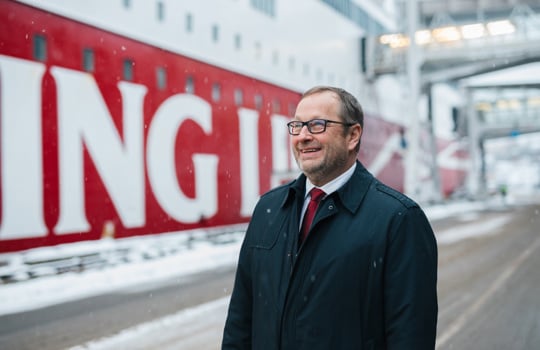Fjord Line trusts in LNG
LNG brings significant environmental benefits for Norwegian shipping company Fjord Line.
Norwegian shipping company Fjord Line has trusted in liquefied natural gas (LNG) for years. The world’s first and largest cruise ferry with single LNG engines, MS Stavangerfjord, began operating in the summer of 2013. Her sister ship, MS Bergensfjord made a maiden voyage in March 2014.
As a result, there has been no need to regret the strategic choice of the clean energy.
– LNG brings us significant environmental benefits. In addition, some ports give us discounts, says Morten Larsen, Project Director of Fjord Line.
An idea of LNG came up, when Fjord Line was planning to order new ships in 2009. The International Maritime Organization IMO and the European Union had decided to tighten the emissions criteria of the maritime transport at the same time.
The use of LNG isn’t the only way Fjord Line is battling against climate change: the sister ships produce their own electricity by converting waste heat from the exhaust gas into steam-generated energy. Thus, MS Bergensfjord and MS Stavangerfjord cover their electricity needs for cabins and communal areas.
Cleaner air all year round
LNG has a significant potential to reduce harmful emissions: the sulfur and particulate emissions of MS Stavangerfjord and MS Bergensfjord are zero. Additionally, the emissions of nitrogen oxides are reduced by 92 per cent lower compared to the traditional heavy fuel oil. The CO2 emissions are lowered approximately by a fifth.
– Along the LNG the working environment in the engine room is also cleaner. In addition, the use of cleaning chemicals has fallen by 80 per cent, says Larsen.
Fjord Line's exclusively LNG-powered cruise ferries operate all year round daily from the cities of Norway to Hirtshals, a town in the northern tip of Denmark. The 170 meter long vessels can accommodate some 1 500 passengers, 600 cars and cargo.
The company consumes about 32 000 tons of LNG per year. MS Stavangerfjord and MS Bergensfjord are fueled in Gasums' bunkering station in Risavika, Norway. The station is equipped by a special loading arm, which significantly speeds up the refueling process.
New opportunities towards fully renewable energy
Although the price of oil has fallen, Larsen points out that LNG is still a competitive alternative fuel. Since liquefied biogas (LBG) is suitable for LNG engines, LBG provides new opportunities to move on towards a fully renewable energy.
In order to enhance the competitiveness and flexibility of LNG, Larsen wishes the focus should be on the development of the infrastructure.
– It is important that the decision-makers continue to support the construction of the LNG infrastructure, he says.

Guide: Liquefied gas for cleaner maritime transports
We have gathered some information for you in a guide about cleaner maritime transports. You will see what influences shipping to reduce emissions, including regulations, market demands and trends.



